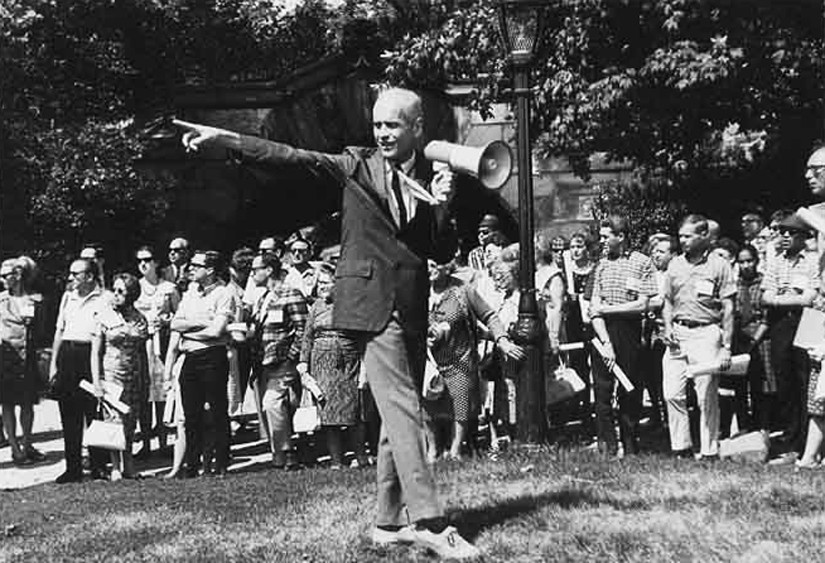
Clay Lancaster
Clay Lancaster, a prolific author, was involved in the efforts to designate the Brooklyn Heights Historic District.
Clay Lancaster received both regional and international recognition for his work in a variety of fields. He was born on March 30, 1917 in Lexington, Kentucky. After college, he went on to receive a master’s degree from the University of Kentucky. During his graduate studies, he realized his talent for drawing precise floor plans. His master’s thesis was a profile on the eccentric architect John McMurtry. This work was published as a book entitled Back Streets and Pine Trees in 1956. Lancaster was also a student of the arts and ideas of the eastern and western worlds. A widely published author, Lancaster wrote at least 20 books, six of which were children’s books, and 150 articles. His works include, Antebellum Houses of the Blue Grass (1961), Old Brooklyn Heights: New York’s First Suburb (1961), Japanese Influence in America (1983), and Architecture of Antebellum Kentucky (1991). Lancaster later established Warwick Publications, a publishing venture, to print his writings.1
After completing his master’s degree, Lancaster moved to Brooklyn Heights and lectured at Columbia University and the Metropolitan Museum of Art. In the 1960s, he became the curator of Prospect Park. He left Brooklyn unhappily in the late 1960s after his apartment was burglarized. He then moved to Nantucket, and subsequently moved back to his home state of Kentucky in 1978. He lived at Warwick, his estate on the Kentucky River in Mercer County, in “blissful solitude.”2 Several years prior to his death, Lancaster founded the Warwick Foundation, an organization whose current mission “is to perpetuate and promote the legacy of Clay Lancaster through education, preservation, and facilitation of cross-cultural understanding.”3 He died on December 25, 2000 at the age of 83, in Harrodsburg, Kentucky.
Clay Lancaster was a pioneer in the field of historic preservation. As a scholar of architectural history, he was devoted to the documentation of American buildings, especially in his home state of Kentucky.4 Lancaster was particularly fascinated by the history of the American bungalow.
While residing in Brooklyn Heights, Clay Lancaster was recruited by the area's active preservation forces. In the late 1950s, preservation leaders in the Heights, such as Otis Pratt Pearsall, had reached the conclusion that there was a substantial legal case to be made for the designation of Brooklyn Heights as an historic district. Consequently, such forces as the Community Conservation and Improvement Council (CCIC), moved to action, and sought the best candidate to document Brooklyn Heights. Henry Hope Reed, Alan Burnham and others among the ranks of the Brooklyn Heights preservation forces, all agreed that Clay Lancaster was the man for the job. CCIC then sought out Lancaster, and he began his work researching and documenting the case for the preservation of Brooklyn Heights. The area which Lancaster surveyed was about eight blocks wide, and fourteen blocks long. Within this small, residential enclave alone, he found hundreds of buildings that were over a hundred years old.5 Lancaster involved Brooklyn Heights residents in his survey of the area.6 By leading walking tours, he trained preservation's leadership, and educated the general public and policy makers regarding the importance of the Heights. In December 1961, Lancaster's findings were published in a book entitled, Old Brooklyn Heights: New York's First Suburb. The book provided the intellectual credibility required in order to make a substantial case for the architectural authenticity and richness of the Heights.7 Lancaster's work also helped generate a major story in The New York Times, published under the headline "Old Brooklyn Heights Groups Fighting to Preserve Buildings."8 As the Brooklyn Heights preservationists had intended, Old Brooklyn Heights proved especially instrumental in guiding the New York City Landmarks Preservation Commission in its efforts to protect the Heights.9
In 2001, the executive director of the Municipal Art Society, Frank Sanchis, said of Clay Lancaster:
"[he] was one of the first people to make a case for the importance of trying to protect buildings in combination, as opposed to just individually."10
- Clay Lancaster Papers
Warwick Foundation
P.O. Box 1183
Lexington, KY 40588
Tel: (859) 865-4225
Email: admin@warwickfoundation.org
- Click here to view the slide presentation that Clay Lancaster used to advocate for historic zoning in Brooklyn Heights during the 1960s.
- "Like Lexington's Historic Architecture? Wish a Happy 100th Birthday to this Scholar," by Tom Eblen, Lexington Herald Leader, March 29, 2017.
- Oral History with Evelyn and Everett Ortner, and Otis Pratt Pearsall
- New York Preservation Archive Project
- 174 East 80th Street
- New York, NY 10075
- Tel: (212) 988-8379
- Email: info@nypap.org
- Douglas Martin, “Clay Lancaster is Dead at 83; Historic Preservation Pioneer,” The New York Times, 9 February 2001.
- Ibid.
- “About the Foundation,” The Warwick Foundation. Article retrieved 2 March 2016
- Douglas Martin, “Clay Lancaster is Dead at 83; Historic Preservation Pioneer,” The New York Times, 9 February 2001.
- Anthony C. Wood, Preserving New York: Winning the Right to Protect A City’s Landmarks (New York: Routledge, 2008), page 199.
- Stanislaw Makielski, The Politics of Zoning: The New York Experience (New York: Columbia University Press, 1966), pages 83-106.
- Ibid.
- Martin Arnold, “‘Old Brooklyn Heights’ Groups Fighting to Preserve Buildings’,” The New York Times, 9 December 1961.
- Anthony C. Wood, Preserving New York: Winning the Right to Protect A City’s Landmarks (New York: Routledge, 2008), page 219.
- Douglas Martin, “Clay Lancaster is Dead at 83; Historic Preservation Pioneer,” The New York Times, 9 February 2001.


